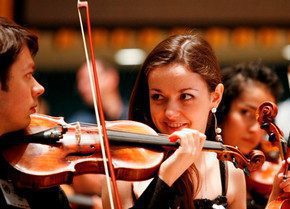How to learn to sing quietly
Listening to world-famous singers, many are surprised: the performers so subtly convey the quiet nuances of a vocal work that even the quietest words can be easily heard from the last row in the hall. These singers sing into a microphone, which is why they can be heard so much, some vocal lovers think, but in fact this is not the case, and you can learn to sing quietly and easily if you do some exercises. At first it seemed so to me, too, until at one classical music concert in a cultural center I heard a singer who had several victories in vocal competitions. When she began to sing, her voice flowed surprisingly softly and quietly, although the girl was singing a classic Gurilev romance.
It was unusual to listen to, especially for those who had been involved in academic singing for many years and were accustomed to a rich and loud sound, but the secret of the singer’s success soon became clear. She simply mastered vocal nuances, pronounced the words clearly, and her voice really flowed like a stream. It turns out that even in academic vocals you can sing subtly and delicately, without imitating opera singers with a forced performance style.
The ability to master quiet nuances is a sign of professionalism of a singer of any style and direction.. It allows you to play with your voice, making the work interesting and expressive. That is why a vocalist of any genre simply needs to sing quietly and subtly. And gradually the technique of filigree performance can be mastered if you regularly do exercises, practice nuances and sing correctly.
Some theory
Singing on quiet nuances is achieved with solid breathing support and hitting the resonators. They contribute to the audibility of voices in any audience. The position of quiet singing should be close so that the timbre is enriched with beautiful overtones and becomes audible even in a distant row of the auditorium. This technique is used by actors in theatrical plays. When words need to be spoken in a whisper, they take low diaphragmatic breathing and form the sound as close to the front teeth as possible. At the same time, the clarity of pronunciation of words is very important. The quieter the sound, the clearer the words.
In constructing quiet nuances, the height of sound formation is also of great importance. It is easiest to sing quietly low and middle notes, more difficult to sing high ones. Many vocalists are accustomed to singing high notes loudly and beautifully, but at the same time they cannot sing quiet sounds at the same height. This can be learned if you hit high notes not with an open and loud sound, but with a quiet falsetto. It is formed by the head resonator on a strong breathing support. Without it, you won’t be able to sing high notes quietly just in bunches.
Singing on quiet nuances can be very expressive if you make the most of the most convenient resonator for the chosen pitch. High notes should be taken with a thin falsetto, without straining the larynx and ligaments, low notes with a chesty sound, a sign of which is vibration in the chest area. Middle notes also sound quiet due to the chest resonator, which smoothly connects with higher registers.
So, for the correct formation of a quiet sound, you need to comply with the following conditions:
How to learn to sing quietly – Quiet nuances
To begin, you just need to sing a certain phrase at medium volume in a comfortable tessitura. If you hit the resonators correctly, it will sound light and free. Now try to sing it very quietly, maintaining the vocal position. Ask a friend to sit in the far corner of the room and try quietly singing a phrase or line from a song without a microphone.
If your voice disappears when you sing quiet notes in a high tessitura, this is the first sign of improper formation of sound on the chords. For such performers, the voice sounds very loud and shrill at high notes or disappears completely.
You can use regular vocal exercises, just sing them in different nuances. For example, sing one part of the chant loudly, another at medium height, and the third quietly. You can use vocal exercises with a gradual rise in the octave and tripling the top sound, which you need to take in falsetto.
Exercises for quiet singing:
- The top sound should be taken as quietly as possible.
- Lower sounds should be clearly audible.
- It will help you learn to clearly pronounce words in quiet nuances and low sounds. A very simple but useful exercise for training the low register of a soprano.
And, of course, decent vocal quiet singing is impossible without examples. One of them could be a scene:
. Notice how Juliet (lyric soprano), a classically trained singer with academic voice training, sings the high notes.
On the stage, an example of correct singing of the top notes can be singer Nyusha (especially in slow compositions). Not only does she have a well-placed top end, but she also sings high notes easily and quietly. It is worth paying attention not to the singing of the verses, but to the way she shows her voice in the passages.
A singer who copes well with low notes and can sing them quietly can be called Laima Vaiukle. Notice how her middle and low register sounds. And how accurately and clearly she plays with nuances on low and medium notes.



